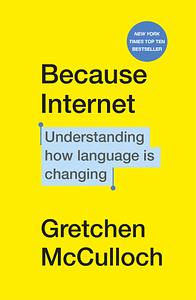You need to sign in or sign up before continuing.
Take a photo of a barcode or cover
IT ME
As soon as I heard about this book, I knew I had to read it immediately, and I'm glad I did - it was absolutely fascinating. It covers the history of internet and social media communities, internet slang, emoticons and emoji, memes, typographical tone of voice, and how the internet provides us with a new way of thinking about language as a living, evolving entity. Great stuff; this second wave semi-internet person enjoyed it immensely. <- non-passive-aggressive full stop
As soon as I heard about this book, I knew I had to read it immediately, and I'm glad I did - it was absolutely fascinating. It covers the history of internet and social media communities, internet slang, emoticons and emoji, memes, typographical tone of voice, and how the internet provides us with a new way of thinking about language as a living, evolving entity. Great stuff; this second wave semi-internet person enjoyed it immensely. <- non-passive-aggressive full stop
Interesting! A linguistic look at how the English language has changed since the introduction of the internet. And memes and emoji and how they came to be and are used.
My one complaint it that this is read by the author and I found myself annoyed by her reading more than once.
Summary: Because Internet is for anyone who's ever puzzled over how to punctuate a text message or wondered where memes come from. It's the perfect book for understanding how the internet is changing the English language, why that's a good thing, and what our online interactions reveal about who we are. Language is humanity's most spectacular open-source project, and the internet is making our language change faster and in more interesting ways than ever before. Internet conversations are structured by the shape of our apps and platforms, from the grammar of status updates to the protocols of comments and @replies. Linguistically inventive online communities spread new slang and jargon with dizzying speed. What's more, social media is a vast laboratory of unedited, unfiltered words where we can watch language evolve in real time. Even the most absurd-looking slang has genuine patterns behind it. Internet linguist Gretchen McCulloch explores the deep forces that shape human language and influence the way we communicate with one another. She explains how your first social internet experience influences whether you prefer "LOL" or "lol," why ~sparkly tildes~ succeeded where centuries of proposals for irony punctuation had failed, what emoji have in common with physical gestures, and how the artfully disarrayed language of animal memes like lolcats and doggo made them more likely to spread.
My one complaint it that this is read by the author and I found myself annoyed by her reading more than once.
Summary: Because Internet is for anyone who's ever puzzled over how to punctuate a text message or wondered where memes come from. It's the perfect book for understanding how the internet is changing the English language, why that's a good thing, and what our online interactions reveal about who we are. Language is humanity's most spectacular open-source project, and the internet is making our language change faster and in more interesting ways than ever before. Internet conversations are structured by the shape of our apps and platforms, from the grammar of status updates to the protocols of comments and @replies. Linguistically inventive online communities spread new slang and jargon with dizzying speed. What's more, social media is a vast laboratory of unedited, unfiltered words where we can watch language evolve in real time. Even the most absurd-looking slang has genuine patterns behind it. Internet linguist Gretchen McCulloch explores the deep forces that shape human language and influence the way we communicate with one another. She explains how your first social internet experience influences whether you prefer "LOL" or "lol," why ~sparkly tildes~ succeeded where centuries of proposals for irony punctuation had failed, what emoji have in common with physical gestures, and how the artfully disarrayed language of animal memes like lolcats and doggo made them more likely to spread.
I really enjoyed this book. It is pretty academic, so I wasn't sure going into it, but I am super interested in the development of language, and I found this a very worthwhile read. The author breaks down why we talk/write the way we do on the internet by looking at why we communicate the way we do in writing, speech, and gesture outside of the internet. And, the text rises above the tired discussions of using language wrong to assert that language grows and changes as we do, and should evolve as technology evolves. And, rather than getting bogged down in the awful debates around using mobile devices and computers too much, the discussion herein is about how we can use the new technologies available to us to better communicate things we couldn't in formal speech and writing. By allowing development of informal communication and opening access to more people, technology is changing and improving the way we communicate. So, if this sounds up your alley, you could do much worse than spending time reading this book.
informative
lighthearted
medium-paced
I loved, loved, loved this.
Things I loved: how she talks about how chat works and how every person has a unique texting style. How she talks about how the internet has allowed the rise of written informal language the same way we’ve had conversational informal language forever. How she talks about how all these things allow us to communicate better and more effectively and in a better personal tone. How she talked about gifs and emojis as cocommunicators-basically gestures. How there was a lot about how language is always changing and people are always freaking about it, but that it’s a good thing. How she talked about the different generations of Internet people, and how Twitter and other social media networks impact language.
There’s so much excitement here for how language changes and the fact that’s a good thing, and the fact that the internet allows us to communicate in new and honest ways and find community. I loved, loved, loved this. So fascinating. So fun. So much the opposite of old man yells at cloud. Though! Be warned. The audiobook is read so fast that at points I literally wondered if I had accidentally sped it up. Do pick this up and talk about these things with the grouchy grammar police in your life.
Things I loved: how she talks about how chat works and how every person has a unique texting style. How she talks about how the internet has allowed the rise of written informal language the same way we’ve had conversational informal language forever. How she talks about how all these things allow us to communicate better and more effectively and in a better personal tone. How she talked about gifs and emojis as cocommunicators-basically gestures. How there was a lot about how language is always changing and people are always freaking about it, but that it’s a good thing. How she talked about the different generations of Internet people, and how Twitter and other social media networks impact language.
There’s so much excitement here for how language changes and the fact that’s a good thing, and the fact that the internet allows us to communicate in new and honest ways and find community. I loved, loved, loved this. So fascinating. So fun. So much the opposite of old man yells at cloud. Though! Be warned. The audiobook is read so fast that at points I literally wondered if I had accidentally sped it up. Do pick this up and talk about these things with the grouchy grammar police in your life.
This book blends 2 of my interests: Linguistics and the History of the internet. I found this book incredibly easy to follow and entertaining. As someone who has spent a lot of time around linguists, the writing style was very familiar and approachable (we're funny people!). She does cite some sociolinguistic studies, especially in the beginning of the book and most were things I had previously read or was familiar with, but I think the book would be enjoyable even without much background knowledge.
Also, there are pictures of lolcats.
Also, there are pictures of lolcats.
To be fair I’m a language nerd but this book is written in an incredibly approachable way. It’s helped me understanding cross generational communication online in new ways but also understand my own way of communicating and connecting online.
A must read.
A must read.
An excellent book that details the history of internet language and the development of current commonplace language additions such as emojis and memes. The emoji and meme chapters were especially fun and interesting. McCulloch compares emojis to sophisticated gesture languages in that out of any context, they don’t hold much meaning, but when combined together with typed language, they can add an air of emotion and have become a way to add tone to a message (sarcasm being one of the biggest tones). This ties into instant messaging and the disappearance of the “third place”. A “third place” is traditionally a physical place that humans have in addition a home and work place. Think Central Perk from the TV show Friends. It’s a place that humans gather for the pure sake of enjoyment with friends. However, these “third places” have slowly disappeared as social media has taken over the role. Within these new “third places”, language transforms to fit new roles such as memes. The original concept of the meme was created by Richard Dawkins in 1976 and was compared to genes in that they are ideas that “spread through social selection and ideological fitness.” Memes have become a form of satirical communication often used in local social groups, but they can go viral and oftentimes do. I’m sure a good majority of us have seen the Baby Yoda memes that have been circulating since Disney+ launched. The truly interesting thing about memes is that they’re a bit like slang in that over time new memes replace earlier and now obsolete memes.
if you like the internet and linguistics this book is *chef's kiss*
Closer to 3.5 and I’m rounding up because the ideas presented in the book are awesome. The reason I wasn’t a full on 4 star is due to a lot of repetition across the pages: mainly on how English is changing.
Still, light, fun and interesting and very informative on how our language rules, words, and understanding changes.
Still, light, fun and interesting and very informative on how our language rules, words, and understanding changes.




